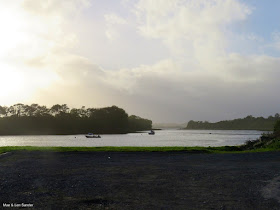"We had Dampfnudeln yesterday,
Dampfnudeln again today
We have Dampfnudeln every day,
We like it fine that way.
Dampfnudel hamma gestern g'habt,
Dampfnudel hamma heut
Dampfnudel hamma alle Dag
Weil's uns halt gefreut!
This nursery rhyme about Dampfnudeln (a type of steamed bun) is typical of the little literary touches in
The Cuisines of Germany, a book I bought recently. The many regions of Germany each have special ways of making traditional dishes, sometimes reflected in the works of famous German authors and in folklore.
In this interesting cookbook published in 1990, Horst Scharfenberg (1919-2006) collected historic recipes, recipes from restaurants, recipes from home cooks, and literary quotations to demonstrate the wide variety of German dishes and food traditions. His approach reminds me of Waverly Root's books on France and Italy -- but with lots of recipes.
Earlier this summer, I blogged a guest post by Evelyn
here: German Food. She agreed with Scharfenberg that culinary critics often underestimate the range and quality of German food. She said: "Yes, wurst, potatoes, schnitzel, and spaetzle are common dishes, but the unsung German emphasis on fresh unadulterated ingredients, and the willingness to place those ingredients front and center of a meal are exactly what the entire slow food movement is based on."
The Cuisines of Germany begins with a region-by-region summary of traditional and twentieth-century German foods including seasonal foods and fresh foods. Each recipe has an introduction, including a description of the sources of the recipes, which sometimes come from quite old cookbooks. Consistent with what Evelyn said, Scharfenberg often refers to Germany's high standards of ingredients and sources, pointing out that many of them originated centuries ago, and that EU regulations at the time he wrote were often less exacting.
The first region discussed in the book is Bavaria, where Evelyn was visiting her in-laws when she wrote her post. Tom, Miriam, and Alice were learning quite a few family recipes during their visit, and they've made us some excellent ones. Scharfenberg is most enthusiastic about Bavarian cuisine. In the course of the book he gives recipes for quite a few special Bavarian dishes Evelyn and Tom have mentioned or cooked for us, such as Bee-Sting Cake, Zwetschgendatschi (damson plum tart), dampfnudln, and Falsche Hase (a meatloaf). Scharfenberg also talks about some Christmas dishes: poppy-seed pudding, Nurenberger Lebkuchen, and weisswurst, which we have enjoyed with the family.
When we first arrived in Ann Arbor, the main choices for eating out here were several German restaurants -- specifically Swabian restaurants run by members of the German community that had immigrated to this area in the late-19th and early 20th century. Scharfenberg includes recipes for many of the dishes I remember in these restaurants. Some of the foods that I remember most: Maultaschen (filled noodles), spaetzle (a type of dumpling), herring salad, zwiebelkuchen (onion cake), and various types of meatballs. The restaurants we liked the best closed some years ago in favor of brew pubs and other more trendy places, and though some incarnations still exist, I consider them extinct.
Scharfenberg often describes his favorite dishes in a rather colorful way, for example:
"I suspect that Maultaschen would have very good chances in a four-way international competition with ravioli, won tons, and pirogi for the championship of the Roughly Rectangular Pasta with Meat (plus Miscellaneous) Filling division." (p. 130)
Many types of potato salad, cabbage slaws and other cabbage dishes, old-style game dishes, and traditional ways to cook chickens, ducks and geese all show up in intriguing sections of
The Cuisines of Germany. Fish dishes include many species of fish caught and eaten in the Baltic areas. Preserved fish such as salt cod and preserved herring are eaten in the land-locked parts of the country. Smoked trout, we learn, came to Germany from America -- European native trout are quite rare and limited to high mountain areas, so American species have been introduced into German streams. Scharfenberg mentioned various recipes and preserved foods that he had not eaten since East Germany became inaccessible, years before he was researching his book.
This is a rather obscure book, long out-of-print. Scharfenberg had a career in German TV and radio food broadcasting, and I believe this is his only work that's appeared in English. Uncomfortably, I learned, he was employed during World War II as a propagandist: "Während des Zweiten Weltkriegs diente er in einer Propagandakompanie als Kriegsberichterstatter," says his German Wikipedia page. The automated translation is "During World War II he served in a propaganda company as a war correspondent." He doesn't seem to have an English Wiki page.
I haven't tried any of his recipes yet, but eventually I hope to do so. And I have often enjoyed the family versions of these dishes.





















































